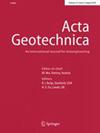Granular flow is a typical process that occurs in sediment disasters, including rockfalls, avalanches and landslides, etc. The runout distance in granular flow is closely associated with the ultimate impact range of these sediment disasters. However, this factor is often highly sensitive to various physical parameters and exhibits significant randomness. Hence the study of granular flow is crucial to elucidating the mechanism of such disasters and even to disaster prevention and mitigation. In recent years, a numerical simulation called discrete element method (DEM) that simulates at the particle level has been widely used in this field. Based on the above situation, this study aimed to capture the critical DEM input parameter combinations for risk assessment in a four-dimensional parameter space considering the particle size distribution. XGBoost feature importance is employed to decide the search priority, and its results indicate that the friction angle with bottom surface (FABS) and coefficient of restitution (COR) are the key parameters. The two key parameter spaces were then comprehensively explored using Gaussian process regression response surfaces. The correlation between the FABS and runout distance appeared as a convex function. The COR exhibited diverse degrees of approximately linear correlation with the runout distance throughout the granular flow. The particle size distribution indirectly led to inconsistencies between the bidisperse flow and other granular flows in the influence mechanisms of the key parameters. By clarifying this effect, we efficiently identified two critical parameter combinations for granular flow DEM simulation.


